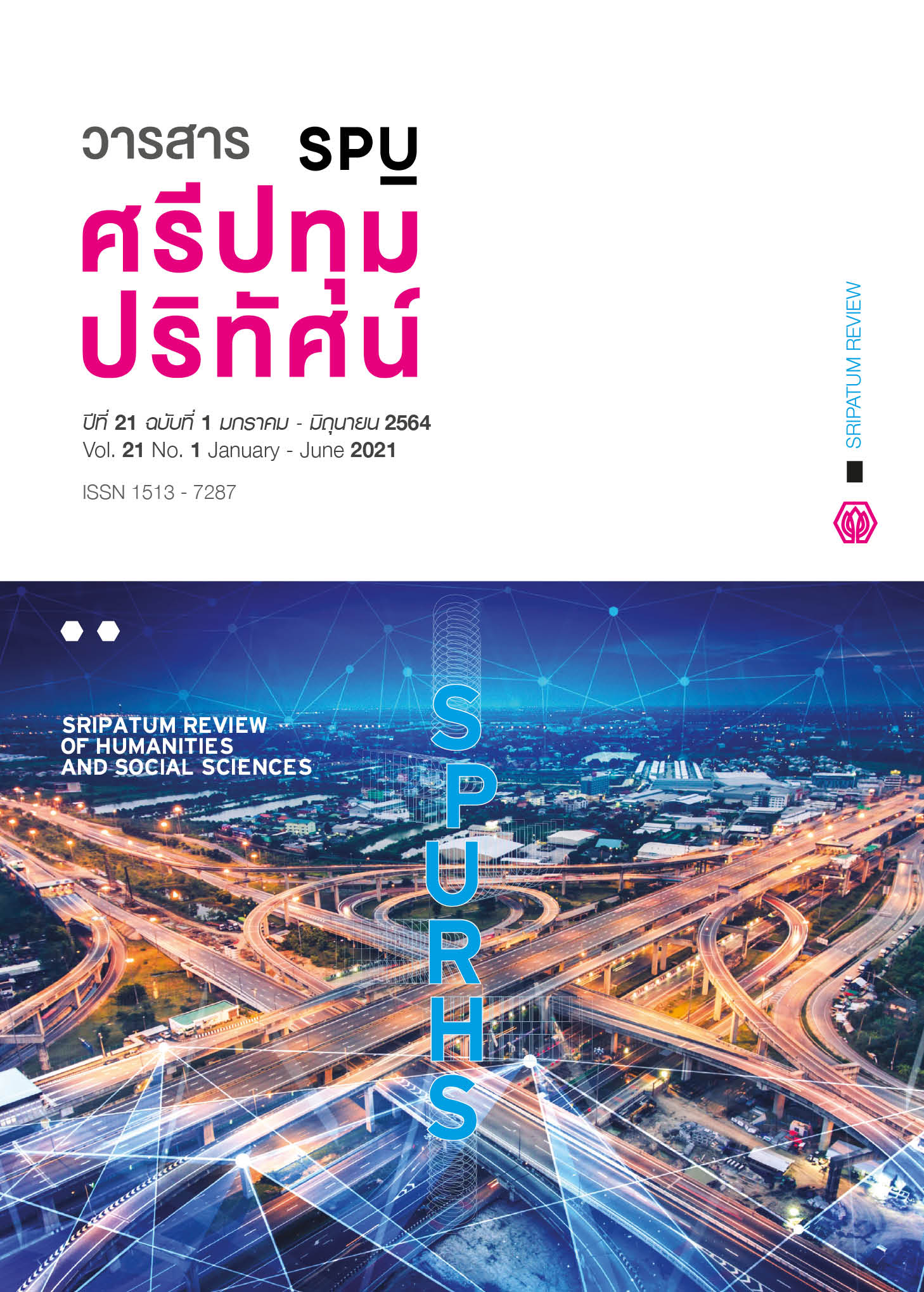A Comparison of Regulations for Agricultural Unmanned Aerial Vehicles in Thailand and Foreign Countries
Main Article Content
Abstract
The purpose of this research was to compare rules and regulations for agricultural unmanned aerial vehicles in Thailand and foreign countries. The research was conducted by studying the criteria, laws, rules and regulations of Japan, the United States of America, Australia and Thailand including the manual for technical operation on the permission for the use of unmanned aerial vehicles for aerial spraying of Japan. This study was a qualitative research. The data from the documents were analyzed with content analysis and comparative analysis. The results of the research revealed that there were 3 aspects of rules and regulations for agricultural unmanned aerial vehicles, which were (1) the application for permission to use agricultural unmanned aerial vehicle, which included the needs to consider the airworthiness of the aircraft, the flying altitude and the spraying area, the format of flying, the permission license for the pilot, the certification for the chemical, and the emergency plan; (2) the flight operation, which included the needs to consider operational guidelines both before and during the flight, such as the dress code of the pilot, the readiness inspection of the aircraft, the inspection of the flying area, the weather condition, the instruction on chemical spraying method, the flying speed and the flying altitude; and (3) the qualifications of the pilot, which included the pilot having passed the examination on both the appropriate theoretical and practical knowledges and skills to fly the unmanned aerial vehicle, such as the knowledge of the rules and regulations, the controlling skills, the use of the chemical, the safety skills, the aircraft maintenance, and the solving of emergency problems.
Article Details
1. กองบรรณาธิการสงวนสิทธิ์ในการพิจารณาและตัดสินการตีพิมพ์บทความในวารสาร
2. บทความทุกเรื่องจะได้รับการตรวจสอบทางวิชาการโดยผู้ทรงคุณวุฒิ แต่ข้อความและเนื้อหาในบทความที่ตีพิมพ์เป็นความรับผิดชอบของผู้เขียนแต่เพียงผู้เดียว มิใช่ความคิดเห็นและความรับผิดชอบของมหาวิทยาลัยศรีปทุม
3. การคัดลอกอ้างอิงต้องดำเนินการตามการปฏิบัติในหมู่นักวิชาการโดยทั่วไป และสอดคล้องกับกฎหมายที่เกี่ยวข้อง
References
Asvathitanon, S. (2016). The Thai Legal concerning Unmanned Aerial Vehicles. Thesis of the Degree of Master of Management Program in Aviation Management. Bangkok: Civil Aviation Training Center. (in Thai)
Eiampan, T. (2019). Human Error Management in Aviation. Sripatum Review of Humanities and Social Sciences, 19(2), 166-176. (in Thai)
Federal Aviation Administration. (2016). FAA's Small UAS Rule (Part 137-Agricultural Aircraft Operations). [Online]. Retrieved April 25, 2020, from: https://www.faa.gov/about/
office_org/headquarters_offices/avs/offices/afx/afs/afs800/afs820/part137_oper.
Federal Aviation Administration. (2016). Small Unmanned Aircraft Regulations (FAR 107). [Online]. Retrieved April 25, 2020, from: https://www.faa.gov/news/ fact_sheets/news_story.cfm?newsId=20516.
Federal Aviation Administration. (2016) Unmanned Aircraft Systems Regulations & Policies 101. [Online]. Retrieved April 25, 2020, from: https://www.faa.gov/uas/recreational_ fliers/where_can_i_fly/airspace_101.
Grand View Research. (2017). Agriculture Drone Market Analysis by Product. [Online]. Retrieved April 20, 2020, from: https://www.grandviewresearch.com/industry-analysis/agriculture-drones-market.
Japan Agricultural Aviation Association. (2006). Criteria on Certification of Operators of Commercial Unmanned Vehicles. Tokyo: Japan Agricultural Aviation Association.
Japan Agricultural Aviation Association. (2019). Technical Guideline on Use of Unmanned Aerial Vehicles for Aerial Spraying. Tokyo: Japan Agricultural Aviation Association.
Kumada, T. (2018). Drone Regulation & Drone Industry Japan. Tokyo: Japan UAS Industrial Development Association.
Ministry of Agriculture, Forestry and Fisheries. (2015). Notification of the Food Safety and Consumer Affairs Bureau 27 Sho-An No. 4545. Tokyo: Ministry of Agriculture, Forestry and Fisheries.
Ministry of Land, Infrastructure, Transport and Tourism. (2015). Transport and Tourism Civil Aeronautics Act. Tokyo: Ministry of Land, Infrastructure, Transport and Tourism.
Ministry of Transport. (2018). Announcement of the Ministry of Transport on Rules to Apply for Permission and Conditions to Control and Launch Unmanned Aircraft in the Category of Remotely Piloted Aircraft. Bangkok: Ministry of Transport. (in Thai)
Prescient & Strategic Intelligence. (2019). Agricultural Drones Market Research Report. [Online]. Retrieved April 25, 2020, from: https://www.psmarketresearch.com/market-analysis/agricultural-drones market.
Siam Yamaha Motor Robotics Co. Ltd. (2019). Unmanned System (UMS) Training Manual. Bangkok: Siam Yamaha Motor Robotics Co. Ltd. (in Thai)
The Australian Trade and Investment Commission. (2019). A World of Opportunities for Australia’s Growing Drone Industry. [Online]. Retrieved August 25, 2020, from: https://www.austrade.gov.au/news/latest-from-austrade/2019-latest-from-austrade/a-world-of-opportunities-for-australias-growing-drone-industry.
The Civil Aviation Authority of Thailand. (2019). Drone Registration Statistics. Bangkok: The Civil Aviation Authority of Thailand. (in Thai)
The Civil Aviation Board. (2019). Regulation of The Civil Aviation Board No. 97 Re: Granting
Licensing to Civil Aviation Business: Commercial Air Transport and Aerial Work. Bangkok: The Royal Thai Government Gazette. (in Thai)
The Civil Aviation Safety Authority. (2016). Civil Aviation Safety Regulations Part 101 - Unmanned aircraft and rockets. [Online]. Retrieved April 25, 2020, from: https://www.casa.gov.au/standard-page/casr-part-101-unmanned-aircraft-and-rocket-operations.
Tonsri, K. (2013). Labor and the Change of Thai Agriculture. [Online]. Retrieved March 14, 2020, from: https://www.bot.or.th/Thai/MonetaryPolicy/NorthEastern/ DocLib_Research/04-Labor%20with%20Agri%20Changing.pdf. (in Thai)


